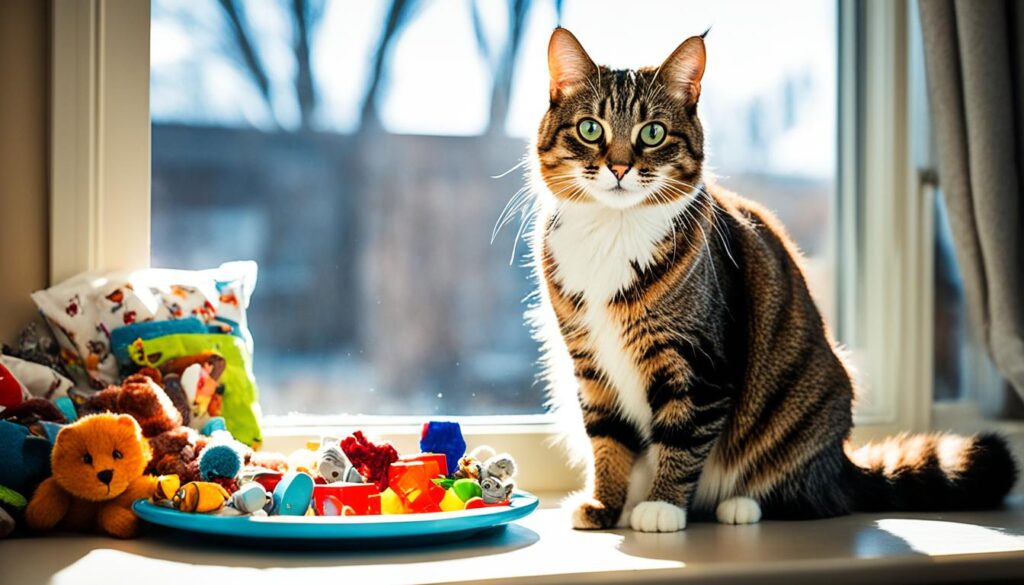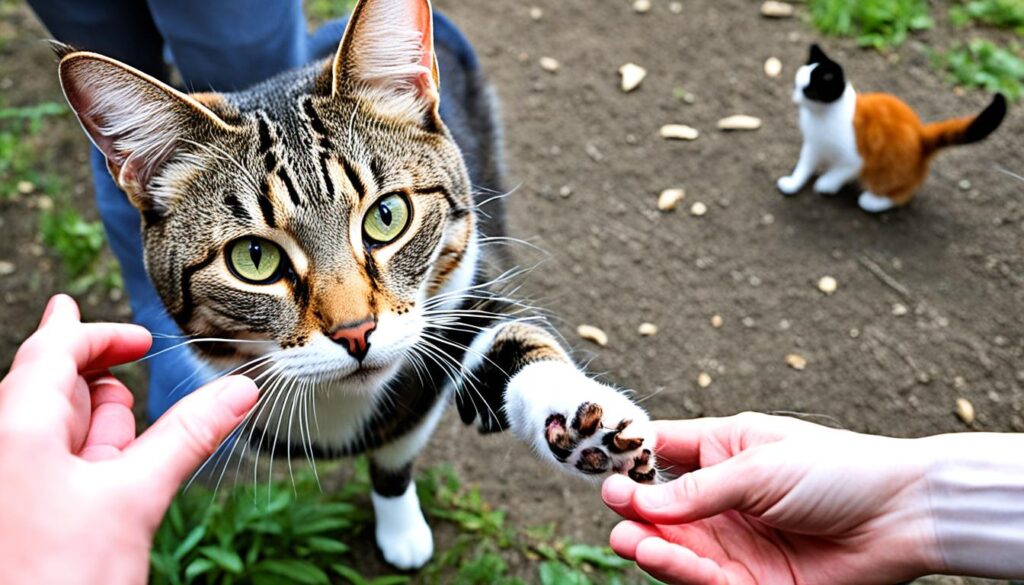How to Tame a Feral Cat?: Did you know that there are millions of feral cats roaming the streets of the United States?
These cats, born in the wild or abandoned by their owners, live in fear and loneliness, often struggling to survive. However, with the right approach and a lot of patience, it is possible to tame these wild creatures and provide them with a loving and secure home.
In this article, I will guide you through the gentle steps of taming a feral cat safely. You will learn how to understand their behavior, build trust through positive associations, and gradually socialize them to become loving companions.
How to Tame a Feral Cat?: Key Takeaways
- There are millions of feral cats in the United States.
- Taming a feral cat requires patience and understanding.
- Building trust through positive associations is crucial.
- Understanding their body language is the key to success.
- With time and consistent effort, most feral cats can become loving companions.
The Three Golden Rules
In order to successfully tame a feral cat, it is important to follow the below 3 golden rules:
- Confining the Cat
-
- Confining the cat to a sanctuary space helps them feel secure and reduces their fear.
- Using Food for Positive Association
-
- Using food as a reward helps feral cats build a positive association with humans.
- Preventing Escape
-
- Feral cats can be difficult to find if they escape, so it’s important to take precautions to prevent them from getting outside.
In order to successfully tame a feral cat, it is important to confine them to a small, safe space, use food as a reward to create positive associations, and prevent them from escaping. By following these three golden rules, you can create an environment that helps the cat feel secure and build trust with humans.
Understanding Different Types of Feral Cats
Feral cats come from various backgrounds, each with their own levels of fear and socialization. These cats can include former companion cats who have been abandoned or lost, and have had to adapt to survive on their own. Additionally, there are first, second, and multi-generation unsocialized cats who have had minimal to no human contact throughout their lives. While the degree of difficulty in socializing feral cats may vary based on their background and genetics, the methods for taming them remain the same.
Regardless of whether a feral cat is a former companion cat or a multi-generation unsocialized cat, the approach to socialization involves patience, consistency, and a deep understanding of their needs and behaviors. By employing gentle techniques and establishing trust, it is possible to help these cats overcome their fears and become more comfortable around humans.
Understanding Feral Cat Body Language
Feral cats have their own unique way of communicating their feelings through body language. By understanding and interpreting these signals, you can gain valuable insights into their level of fear and comfort. This knowledge is crucial in determining the progress of their socialization with humans.
When observing feral cats, you may notice certain behaviors that indicate fear and anxiety. These can include crouching low to the ground, hissing, or seeking hiding spots. These defensive postures serve as a protective mechanism, signaling their discomfort and the need to maintain distance.
On the other hand, feral cats may display signs of curiosity or a growing level of comfort. This can be seen through making eye contact or vocalizing, indicating a willingness to engage or explore their surroundings. These behaviors suggest a gradual recognition of a less threatening environment.
Interpreting feral cat body language requires patience and keen observation. By paying attention to their nonverbal cues, you can gauge their progress in becoming more comfortable with humans. Recognizing and responding appropriately to their signals can help build trust and facilitate their socialization journey.
| Behavior | Meaning |
|---|---|
| Crouching | Indicates fear and anxiety |
| Hissing | Displays defensive behavior |
| Hiding | Signifies a need for safety and distance |
| Eye contact | Suggests curiosity and a growing level of comfort |
| Vocalizing | Indicates a willingness to engage or explore |
Using Calming Signals to Build Trust
When working with feral cats, it’s crucial to understand their fear and anxiety and find ways to build trust. Calming signals can be effective in establishing a sense of safety and security for these cats. By using specific techniques, you can communicate to the feral cat that you mean no harm and create a more relaxed environment for them.
- Slow movements: Feral cats are easily startled by sudden, fast movements. To create a calming environment, move slowly and deliberately around them. Avoid any sudden gestures or actions that may cause them to feel threatened.
- Walking in an arc: Instead of approaching a feral cat head-on, walk in a gentle arc towards them. This indirect approach helps to lessen their fear and allows them to observe you from a safe distance.
- Softening your body and face: Conveying a relaxed and non-threatening demeanor is essential. Soften your body language by keeping your shoulders relaxed, lowering your stance, and avoiding direct eye contact. A relaxed face with a gentle expression can make a feral cat feel more at ease.
- Looking downwards and to the side: Direct eye contact can be intimidating and threatening for feral cats. Instead, glance downwards and to the side, which communicates that you are not a threat and respect their personal space.
- Slow blinks or “cat kisses”: Slowly blinking your eyes at a feral cat is a way to show them trust and acceptance. This behavior, known as “cat kisses,” mimics the friendly gestures cats use to communicate with each other.
- Yawning: Yawning in the presence of a feral cat can signal relaxation. Cats often yawn when they are in a comfortable and secure environment, so mirroring this behavior can help put them at ease.
- Slowing your breath: Feral cats can sense when a person is tense or anxious. By consciously slowing your breath and maintaining a calm and steady rhythm, you can help create a soothing atmosphere.
- Being still when you come to a rest: When you stop moving, be still and give the feral cat time to observe you. Impose no physical or mental pressure on the cat in these moments and let them approach you when they feel comfortable.
Using these calming signals can help gradually build trust with feral cats. By respecting their boundaries and communicating in a calming and non-threatening manner, you can establish a foundation of trust and create a positive environment for their socialization process.
Using Treat Foods to Encourage Socialization

Treat foods play a crucial role in the rehabilitation and socialization of feral cats. By using special treats, you can entice these cats to overcome their fears and gradually develop trust. Experimenting with different food options can help you find the ones that the cat responds to most positively. Here are some examples of treats that can be highly effective:
- Gerber meat baby food
- Hills a/d tinned food
- Fresh liver
- Dried liver
- Royal Canin Persian adult dry food
- Ultimates Indulge tinned fish cat food
- Peck’s Ham and Cheese spread
- Prawns
- Roast chicken
- Dine creamy treats
- Homemade chicken broth
These treats can serve as rewards during the socialization process, providing positive reinforcement and motivation for the cats. By associating these special treats with your presence, the cats will gradually overcome their fear and become more comfortable around you. Remember, each cat may have different preferences, so it’s important to observe their reactions and adjust accordingly to optimize the effectiveness of the treats.
Using treat foods can be a powerful tool in the process of rehabilitating and treating feral cats. These treats not only help in building trust and fostering a positive relationship but also provide essential nutrition during this critical period of socialization. Incorporating special treats into your approach can greatly enhance the effectiveness of your efforts towards rehabilitating these once-wild cats.
Building Trust with a Feral Cat: A Step-by-Step Guide
Socializing a feral cat can be a challenging but rewarding process. By following a step-by-step guide, you can gradually build trust with the cat and help them become more comfortable around humans. Here is a detailed breakdown of the feral cat socialization steps:
1. Desexing and Microchipping: Start by ensuring the cat’s health and safety. Desexing and microchipping the cat will not only prevent unwanted litters but also provide identification if they ever get lost.
2. Avoid Staring: Feral cats may interpret direct eye contact as a threat. Instead, avert your gaze or offer soft, slow blinks to convey a non-threatening presence.
3. Confinement in a Safe Space: Provide the cat with a small room or crate where they can feel secure. This helps them adapt to their environment and reduces their fear.
4. Positive Associations with Food: Use food as an incentive to create positive associations with your presence. During feeding times, offer delicious treats and talk softly to the cat, gradually getting them used to your presence.
5. Gradual Introduction of Touch and Interaction: Begin with offering food on a spoon or finger, allowing the cat to approach and eat at their own pace. As they become more comfortable, introduce gentle touches and handling, always respecting their boundaries.
6. End on a Positive Note: Each session should end with a positive interaction. Offer a treat or provide a comforting petting session before allowing the cat to retreat to their safe space.
Remember, building trust with a feral cat takes time and patience. Every cat is unique, so the timeline for each stage of socialization may vary. Celebrate milestones along the way, such as increased relaxation and trust, as these indicate progress in the socialization process.
By following these steps and providing a safe and nurturing environment, you can help a feral cat transition from survival mode to a loving companion.
Helpful Tips for Building Trust:
- Be consistent in your interactions and routines to establish trust.
- Keep the environment calm and free from loud noises or sudden movements that may startle the cat.
- Observe the cat’s body language and respect their boundaries. Let them dictate the pace of interaction.
- Consider using calming remedies, such as Feliway or pheromone diffusers, to create a tranquil atmosphere.
Things to Celebrate During the Taming Process

There are certain signs and behaviors that indicate progress in taming a feral cat. These milestones serve as important markers in the socialization journey and can be celebrated to reinforce the positive association between you and the cat.
- **Blinking at You**: When a feral cat blinks at you, it shows that they are comfortable and trust you to some extent. It’s a subtle but significant gesture that signifies their growing acceptance.
- **Ears Forward Instead of Flattened Back**: Feral cats often flatten their ears when they feel threatened or scared. As their trust in you increases, their ears will gradually move forward, indicating a more relaxed and confident state.
- **Arms Folded Upside Down Under Their Body**: This behavior, known as the “loaf position,” is a positive sign that the cat feels safe and secure in your presence. It demonstrates their willingness to let their guard down and be more vulnerable around you.
- **Increased Relaxation and Trust During Interactions**: Over time, you may notice that the feral cat becomes more relaxed and at ease during your interactions. They may allow you to pet them or even initiate physical contact themselves, indicating a deeper bond and trust between you.
Celebrating these milestones not only acknowledges the cat’s progress but also reinforces the positive association they have with you. It’s crucial to remember that every feral cat’s journey is unique, and milestones may be reached at different times. Patience, consistency, and respect for the cat’s boundaries are key to achieving these milestones and successfully socializing a feral cat.
| Milestone | Behavior |
|---|---|
| Blinking at You | Indicates comfort and trust |
| Ears Forward Instead of Flattened Back | Signifies relaxation and confidence |
| Arms Folded Upside Down Under Their Body | Shows a sense of security and vulnerability |
| Increased Relaxation and Trust During Interactions | Reflects a deeper bond and trust with the cat |
Tips for Taming Semi-Feral Cats
Taming semi-feral cats requires patience and consistent effort. These cats may have had limited or negative experiences with humans, making it challenging to build trust. However, with the right approach and techniques, you can help these cats become more comfortable around humans and gradually socialize them.
1. Let the Cat Make the First Move
Respect the cat’s boundaries and allow them to approach you at their own pace. Avoid chasing or grabbing the cat, as it can trigger fear and aggression. Instead, create a safe and inviting environment by providing hiding spots, comfortable bedding, and food and water stations.
2. Provide Positive Interactions
Show the cat that you are a source of positive experiences. Offer them treats or special food during feeding times, using it as an opportunity to create a positive association with your presence. Maintain a calm and gentle demeanor, speaking softly and avoiding sudden movements.
3. Desensitize to Human Presence and Noises
Expose the cat gradually to unfamiliar human presence and noises. Start by spending time near the cat’s hiding spot, engaging in quiet activities such as reading or talking softly. Gradually increase the interaction level, allowing the cat to observe you and acclimate to your presence.
4. Respect Their Space
Respecting the cat’s personal space is crucial in building trust. Avoid invading their territory or making sudden advancements. Instead, give them the freedom to approach or retreat as they feel comfortable. Over time, the cat may become more curious and willing to engage in interactive play or gentle petting.
5. Consider Calming Remedies
Some semi-feral cats may benefit from natural calming remedies. Consult with a veterinarian regarding the use of pheromone sprays or diffusers, which can help create a soothing environment. Additionally, herbal supplements or calming treats may help reduce anxiety and facilitate the taming process.
With time, patience, and consistent effort, semi-feral cats can learn to trust humans and become more socialized. Remember, every cat is unique, and the taming process may take several months or even up to a year. By providing a safe and nurturing environment, respecting their boundaries, and using positive reinforcement, you can help these cats overcome their fears and live happy, social lives.
Conclusion
Taming wild cats, such as feral cats, requires dedicated time and effort. Through gentle steps and building trust, feral cats can be socialized and become comfortable around humans. Patience is key, as the process may take weeks or even months, but with consistent care, positive reinforcement, and understanding, most feral cats can be transformed into loving companions.
Celebrating milestones during the taming process is important as it reinforces the positive association with humans and acknowledges the progress made. Providing a safe and comfortable environment for the cat is crucial as they continue to adjust to their new home.
If you are considering feral cat adoption, remember that caring for feral cats requires special attention. Be prepared to invest time and resources to ensure their well-being and happiness. The feral cat adoption process may entail additional steps to ensure the cat’s successful integration into a domestic environment.
FAQ
How do I tame a feral cat?
What are the three golden rules for taming a feral cat?
What are the different types of feral cats?
How do I understand feral cat body language?
How can I use calming signals to build trust with feral cats?
What treat foods can I use to encourage socialization in feral cats?
What is the step-by-step guide to taming a feral cat?
What are some milestones to celebrate during the taming process?
How do I tame semi-feral cats?
How long does it take to tame a feral cat?
What should I consider during the feral cat adoption process?
References
| International Cat Association (TICA) | https://www.tica.org/ |
| The Cat Fanciers’ Association (CFA) | https://cfa.org/ |
| World Cat Federation (WCF) | https://www.wcf-online.de/ |
| Fédération Internationale Féline (FIFe) | https://www.fifeweb.org/ |







